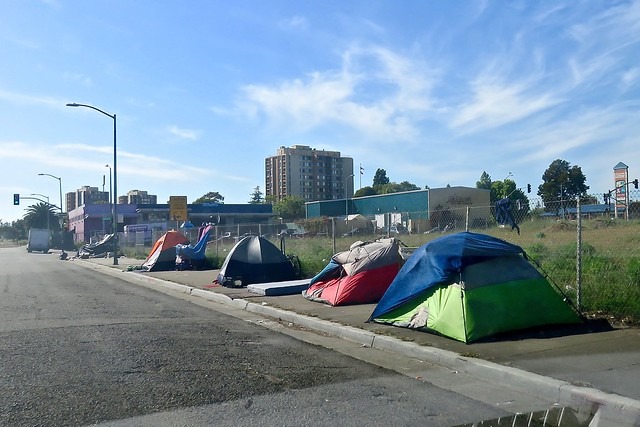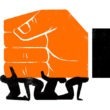If President Trump has his way, things are about to go from bad to worse for America’s poor. On May 7, the Office of Management and Budget proposed changing the way that poverty gets measured in the U.S. The public has 45 days to respond to this proposal (June 21); then the government will decide whether to change the official U.S. poverty measure. Information on how to submit comments appears at the end of this article.
The President’s plan doesn’t directly or immediately affect how much money is required to not be poor. That stays the same for now. Rather, the plan changes how we go about measuring inflation. At present, poverty thresholds are increased each year based on the official U.S. measure of inflation, the consumer price index (CPI). The President wants the U.S. government to replace the current measure with something called “the chained CPI.” This will slowly lower U.S. poverty thresholds over time, with bad consequences.
Before we get to this, a little background is needed.
Following publication of The Other America by Michael Harrington in 1962, President Kennedy requested some poverty statistics from his economic advisors. Mollie Orshansky of the Social Security Administration was asked to perform the task of developing a poverty measure for the U.S. She was the perfect person to do this. Orshansky was a specialist in family living standards and income adequacy and had been studying household budgets for decades.
Her main task was to find the minimal income that would enable a household to survive for one year. She began with U.S. Agriculture Department data on the minimum food requirements for families of different sizes, and then priced out how much it would cost to purchase this food. Next she examined government surveys of household expenditures undertaken during the 1940s and the 1950s. Orshansky found that families, on average, spent around one-third of their income on food. So she multiplied the cost of a minimum food budget for each family type by three to arrive at its poverty threshold. These thresholds represented the minimum income needed by families (of different sizes) to survive during the year.
The poverty rate measures the fraction of all U.S. households that fail to meet its poverty threshold. Each year poverty thresholds get increased by the CPI. This ensures that the purchasing power of income needed to not be poor stays the same over time. Due to inflation, $1,600 in 1963 (the poverty threshold for a single individual) can’t buy very much in 2019. Increasing the 1963 poverty threshold with inflation gives us a 2019 poverty line of $12,490 for a single individual. This figure represents the same purchasing power $1,600 had in 1963.
The original poverty measure is insufficient and out of date
Orshansky actually presented the administration with two sets of poverty thresholds (each set with a different threshold for families of different sizes). One was for emergency circumstances only; it provided enough food to survive for a short period of time, but not sufficient nutrition from food to last an entire year. The other was based on food requirements that would provide for adequate nutrition for an entire year. The Johnson administration, worried about the consequences of reporting very high poverty rates in the U.S. during the Cold War, chose the lower of the two poverty thresholds.
The U.S. government made Orshansky’s definition the official U.S. measure of poverty in 1965. At this time Federal agencies began using this measure to determine eligibility for a vast array of federal programs such as housing vouchers, Medicaid, school lunches and SNAP (formerly Food Stamps). When new government programs begin, such as Obamacare, eligibility is also determined by household income relative to that household’s poverty line. This is why President Trump’s proposal is so concerning. Right at a time when extremes of wealth and poverty are increasing, Trump proposes to make it harder to qualify for anti-poverty programs and benefits.
The Orshansky poverty measure has been criticized a great deal over the years. One objection has been that it relies on the smaller emergency food budget to measure poverty. Effectively, it uses a food budget that does not provide minimum food needs for twelve months as its base for determining the poverty line for an entire year. Orshansky herself stressed that the emergency food budget was not adequate for measuring poverty, but was over-ruled by government officials.
Second, Orshanky assumed that all food would be purchased at a grocery store and consumed at home. Her formula assumed that the person shopping for the household would do so with substantial knowledge of the nutritional value of all food and would buy food to just meet the minimum nutritional needs of their family. Further, it assumed that nothing would go to waste and that there would be no snacks for either adults or children.
A third problem is that the Orshansky poverty measure is outdated in many ways. One way it is out of date is that it doesn’t include either government benefits to the poor or taxes paid. This problem has been dealt with through the Supplemental Poverty Measure that was instituted in 2010. This calculation doesn’t replace the official Orshansky measure of poverty; and it isn’t used to determine eligibility for government benefits. The supplemental measure is reported in addition to the official measure. Because it includes government benefits as part of income when determining poverty status, it allows us to track the impact of government anti-poverty programs on the U.S. poverty rate (which is impossible if we don’t take these programs into account when measuring poverty).
The Orshansky measure is also outdated because it doesn’t account for the fact that what is needed today to not be poor is much greater than what was needed in the 1960s. Cell phones, personal computers and Wi-Fi did not exist in the early 1960s; today they are necessary to apply for and get a job. In addition, in the early 1960s, a typical household had a male breadwinner and a stay-at-home wife to care for the home and the children; there were no child care expenses. Today child care is one of the largest household expenditure categories. Families also eat out more now because there is no one who stays at home to cook, and are also more likely to hire someone to take care of chores like cleaning the house and mowing the lawn.
This is important because it greatly affects our estimate of poverty. If we followed the Orshansky methodology today, and used the fraction of total household spending on food to measure poverty, we would have a food multiplier of something close to five rather than a food multiplier of three. This would raise poverty thresholds by more than 50% and would sharply increase the estimate of poverty in the United States.
Finally, and to come back to the point about inflation, there is good evidence that the poor pay more for things and that this condition is getting worse over time. Here is a simple example illustrating this point. When I buy things (almost always using my credit card) I get money back from my credit card company (or points to obtain things like free air travel). Credit card companies charge merchants when people pay by credit card (and the money I get back is an incentive to use my card). Merchants then pass this cost to consumers. So while prices have gone up for everyone, the poor who don’t have credit cards and pay by cash wind up paying more than me and more than average.
The chained CPI was first introduced by the Bureau of Labor Statistics in 2002. It was an attempt to provide a more accurate measure of inflation facing the average household or consumer. But it is not clear that it achieves that objective.
The regular CPI comes from taking the goods and services bought by a typical family and seeing how the cost of buying these things changes over time (each month and each year). Estimates of what people buy comes from surveys of households that are done very infrequently (every 5 years or so), rendering them quickly out of date.
Chained CPI method yields unreliable estimates
People do make regular changes in what they buy, particularly in response to sudden price changes; and these changes impact our estimates of inflation. The chained CPI uses sales data from firms to make these computations each month. For example, if the price of apples doubles, I will buy fewer apples and buy more bananas, pears and other fruit. Assuming that I still buy the apples after the price doubles (as the official CPI does) leads to an overestimation of inflation. Here the chained CPI gets things right. I am facing lower inflation than the regular CPI estimates because I buy fruit other than apples; the cost of buying fruit changes very little and I still eat sufficient servings of fruit.
However, many cases don’t work like this. If the price of gasoline doubles, everyone will spend less on gasoline, and less time driving. Unlike the apple example, the result will not be a simple switch in buying habits at the grocery store. I can’t fill my car with something else and have it run as before; rather, I am forced to use mass transit rather than driving to work.
The important question is how this will affect the poor. We know that a large portion of the U.S. population lives paycheck to paycheck. According to a Federal Reserve survey, 40% of U.S. households could not easily come up with $400 for an emergency such as a car repair or medical bill. These households would have to drive less if gasoline prices doubled. They couldn’t afford the extra cost of gasoline. The result will be cheaper commutes to work on mass transit, which the chained CPI assumes when it computes inflation.
This shift to mass transit, however, will not make low-income households any better off; and unlike the fruit example, the consumption switch will adversely impact on their standard of living. People drive to work for a reason. Usually that reason involves the lack of options. If the choice is between a 30 minute drive to work (each way) and a 2 hour commute (each way), driving makes a great deal of sense. A shift to mass transit when gasoline prices rise will cut down on commuting costs, but will lead to other costs—such as the need for more child care and the need to hire people to do regular chores. Just as important here, there is the cost of the lost time (15 extra hours per week commuting to work). For most people, and especially for low-income individuals, a large fraction of their regular expenditures are on things that can’t easily be changed when prices rise—housing, transportation, health care, and child care. The chained CPI assumes that these changes are costless and have no impact on people besides switching the goods and services they purchase.
The chained CPI has already been incorporated into the U.S. tax code. The 2017 Republican tax plan gave low-income and middle-income taxpayers very small tax cuts. But because the law specified that the chained CPI will be used to adjust tax rates every year, and because the chained CPI results in lower estimates of inflation than at present, most Americans will be seeing small tax hikes over the next several years. In another 5 years, they will be paying more in taxes than they would have paid before the 2017 law took effect.
Similarly, moving to a chained CPI for measuring poverty will reduce poverty thresholds and reduce official U.S. poverty rates. These changes will be magnified over time due to compounding. After 10 years, chained CPI would leave poverty thresholds 2.4% lower compared to using the regular CPI, as we do now; after 20 years, the difference would be 5%.
Like the decision to use Orshansky’s lower poverty thresholds (based on an emergency food budget that could not provide nutritious food for the year), the decision about measuring poverty is ultimately a political decision. The President has decided that he wants lower poverty thresholds, even though most scholars who have studied the issue carefully have concluded that the U.S. poverty thresholds are too low at present—the thresholds were not sufficient for a decent standard of living in the early 1960s and they cannot provide for a decent standard of living today.
Using the chained CPI to measure inflation will hurt the poor because they will get fewer government benefits since most benefits are predicated on having an income that is some percentage of the poverty line for that family (remember, families of different sizes have different poverty thresholds). And this is exactly what the President’s plan wants to do.
There is a final nefarious consequence of converting to the chained CPI—some people will no longer be counted as poor. Measured poverty in the U.S. will fall over time just because of this definitional change; yet no one will be better off as a result of the change (and many will be worse off, as argued above). And, of course, the President will boast of the great job he has done lowering poverty in the U.S. Moving to the chained CPI is a poor policy proposal that will adversely affect the least well-off Americans. We should all do what we can to stop it.
Steven Pressman is Professor of Economics at Colorado State University, author of Fifty Major Economists, 3rd edition (Routledge, 2013), and President-Elect of the Association for Social Economics.
Comments about the President’s plan to change how we measure poverty should be addressed to: Nancy Potok, Chief Statistician, Office of Management and Budget, fax number (202) 395-7245. Email comments may be sent to [email protected], with the subject “Directive No. 14”. Alternatively, comments can be sent via www.regulations.gov—a government website that allows people to review, and respond to, government documents and plans.







I am not surprised that a snake oil sales man like Trump will use slight of hand to cheat the poor. However I know in my heart he did not come up with this plan. Some buck-toothed rodent that has his ear, always wanted to do this and it took very little to convince Trump to do so. If taking food out of the mouths of poor families is Trump’s idea to winning. I’m tired of winning and him. He has to go along with his administration. It took Obama’s full 8 years to climb out of the hole that Bush and his team left us in. How long will it take to wash the taste from our mouths from the Trump administration? There will be a day of recognition. It can not come to soon.